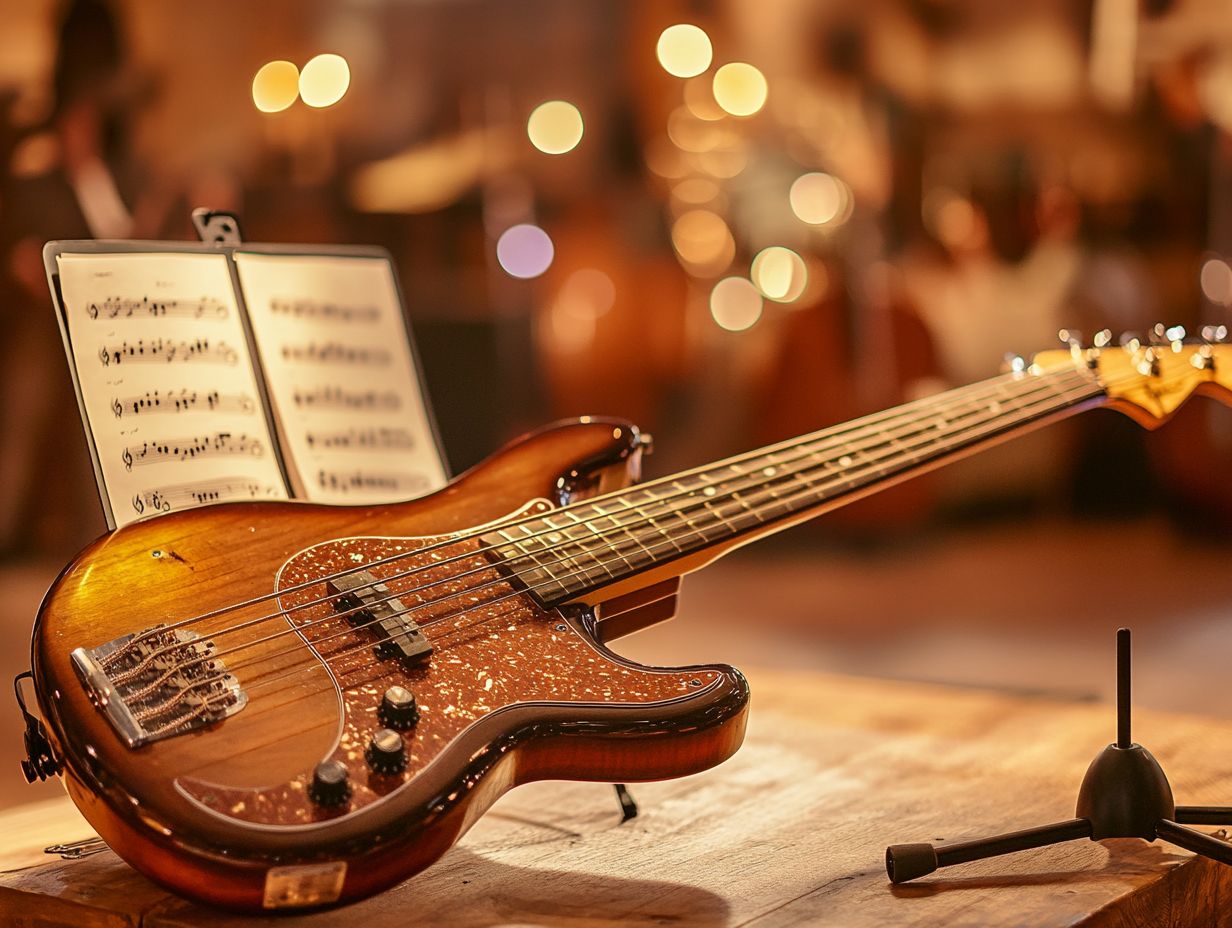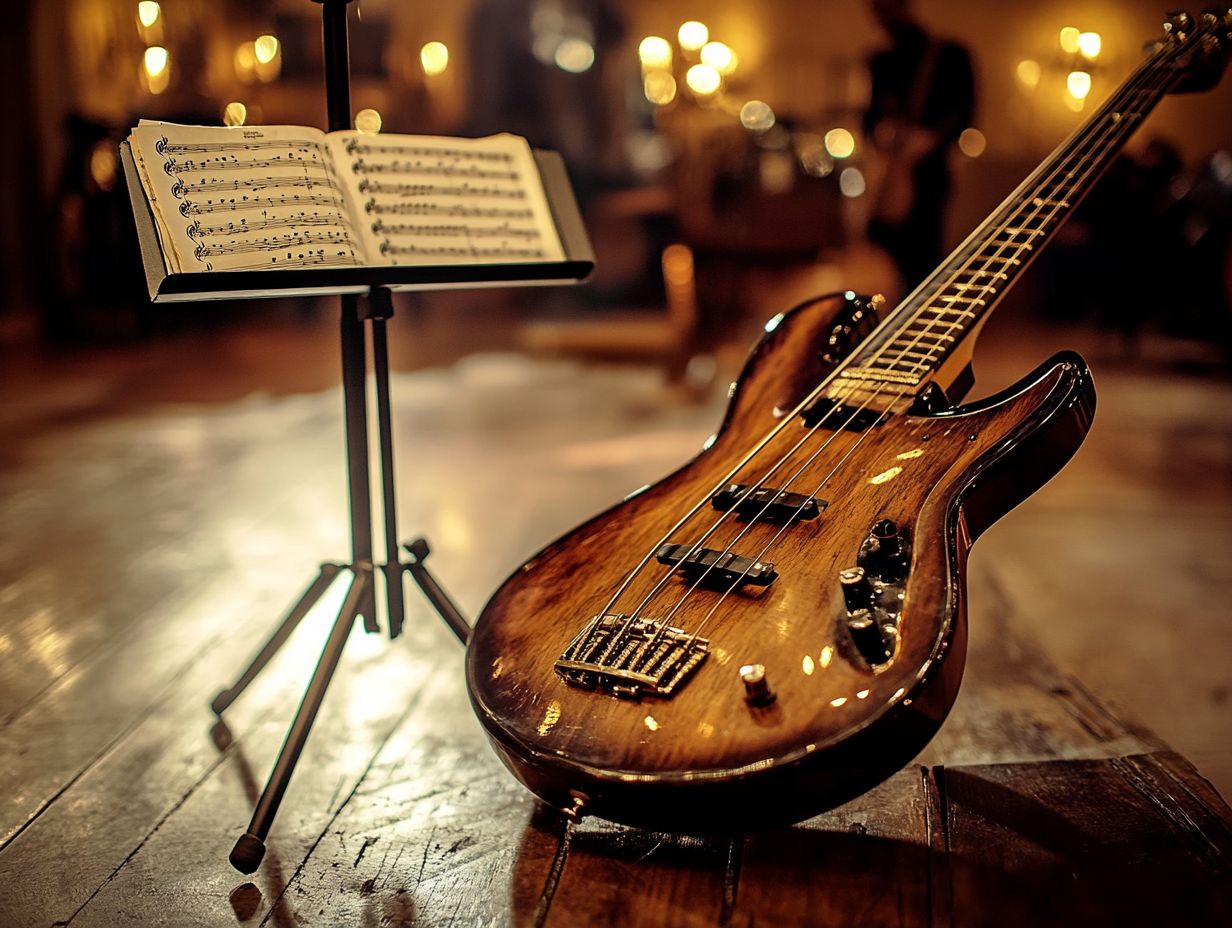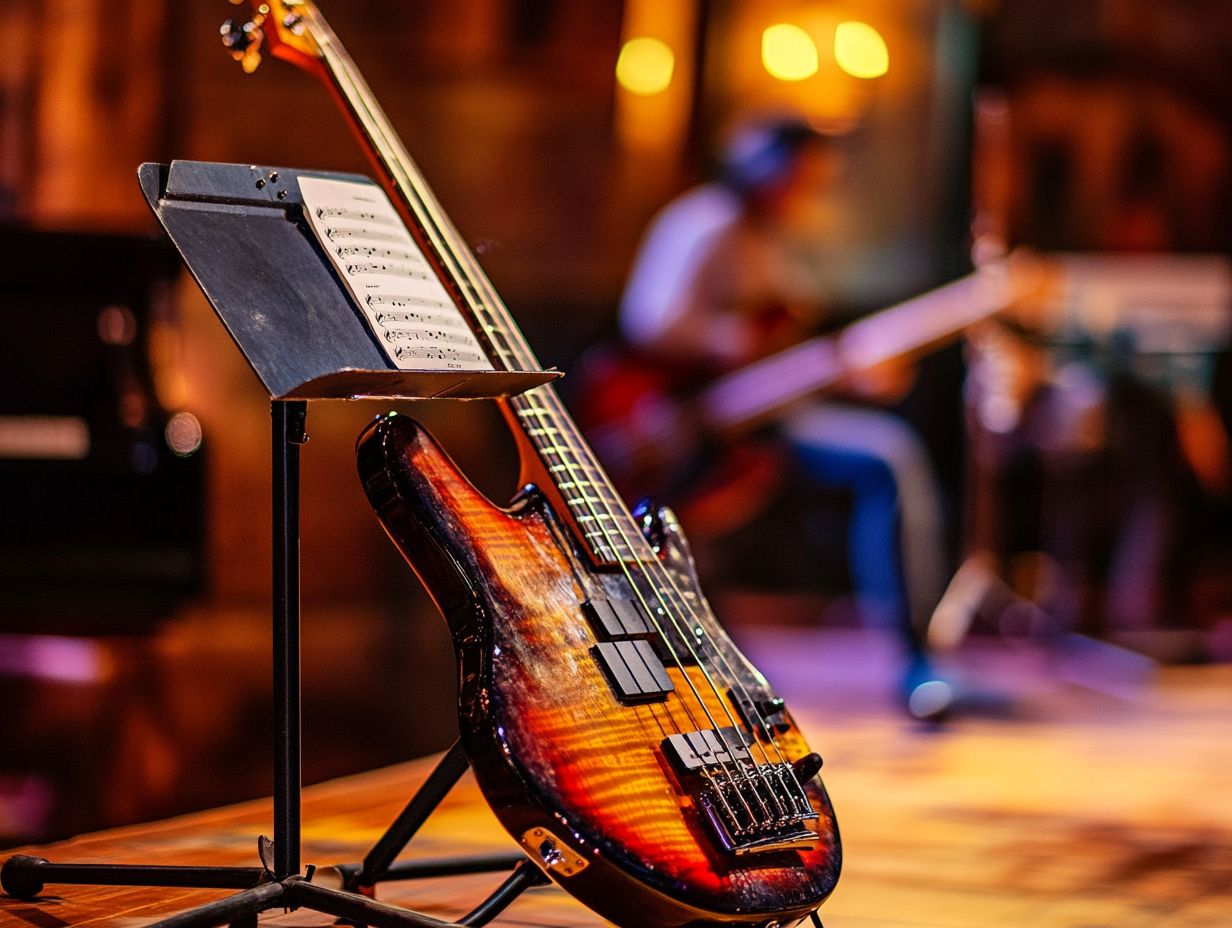The bass guitar is not merely a stringed instrument; it serves as the heartbeat of countless music genres, adding rhythm and depth to every performance.
In this guide, you will discover what makes the bass guitar essential in music, how to choose the right instrument for your style, and the anatomy that contributes to its unique sound.
We will also explore fundamental techniques, exercises to enhance your skills, and tips for mastering the instrument. Whether you are a beginner or looking to refine your craft, this guide will provide a solid foundation for your bass guitar journey.
Contents
What is a Bass Guitar and Why is it Important?

The bass guitar is a vital instrument in contemporary music, bridging rhythm and melody across various genres, including jazz, rock, funk, blues, and pop. Its ability to produce lower frequencies creates a strong foundation for songs, enabling musicians to employ intricate music theory techniques and compositional methods.
Understanding the role and significance of the bass guitar can enhance one’s listening experience and appreciation of different musical styles, making it an essential aspect for both aspiring bass players and music enthusiasts alike.
Getting Started: Choosing the Right Bass Guitar
Choosing the right bass guitar is crucial for any musician to ensure optimal playability, sound quality, and overall performance. There are various types of bass guitars available, including fretless bass guitars, 5-string bass guitars, and 6-string bass guitars.
It is essential to understand the different types of strings, pickup configurations, and body shapes to select an instrument that aligns with your playing style and musical preferences.
Factors to Consider when Choosing a Bass Guitar
When choosing a bass guitar, several factors—including construction, string types, pickup types, neck profile, and body shape—significantly influence sound quality and playability. Each variation in these factors contributes to the overall tone of the bass guitar, so musicians must carefully weigh their options.
The construction of the bass guitar, whether it is a solid or hollow body, affects its tonal characteristics. A solid body bass guitar typically delivers a punchier sound, making it suitable for rock and funk styles, while a hollow body bass guitar produces a warmer tone with greater resonance, which is better suited for jazz.
The type of strings used on a bass guitar, specifically whether they are roundwound or flatwound, plays a crucial role in shaping its overall sound. Roundwound strings, constructed from a wire wrapped around a core, provide a bright tone with increased sustain, making them ideal for slap and pop techniques. In contrast, flatwound strings, made with a smooth wire, produce a more subdued and mellower sound that fits well within vintage music genres.
Pickup types, such as single coil versus humbucker, are also important determinants of a bass guitar’s output. Single coil pickups offer a brighter and more articulate sound, which is beneficial for jazz solos, while humbucker pickups provide a thicker and more aggressive tone, making them suitable for metal riffs.
Although the neck profile and body shape of a bass guitar do not directly affect sound output, they significantly impact playability, which ultimately determines the musician’s ability to produce the desired sound.
Understanding the Anatomy of a Bass Guitar

The anatomy of a bass guitar refers to its various parts and their significance for playing techniques and sound production. Key components of a bass guitar include the neck, body shape, pickups, and materials such as tonewood.
Understanding the anatomy of a bass guitar is crucial for assessing the instrument’s character and sound quality, as well as for ensuring proper maintenance and playability.
Key Parts and Functions
The components of a bass guitar, including the pickups, bridge, and neck, each serve specific functions that contribute to the instrument’s overall sound and playability. By understanding these components, bass players can optimize their performance and effectively utilize amplification and effects pedals to enhance their tonal palette.
The pickups, located beneath the strings, are responsible for capturing the vibrations of the strings and converting them into electrical signals. Their interaction with the strings directly influences tone and volume, allowing musicians to achieve both subtle nuances and bold expressions.
The bridge plays a crucial role in affecting the tension and intonation of the strings, as well as the resonance of the music throughout the body of the instrument. Meanwhile, the design of the neck influences playability and the range of notes accessible to the player. These elements are integral to a bassist’s technique.
With a variety of amplification options and effects pedals at their disposal, bass guitarists can explore a wide range of sounds, from punchy lows to melodic highs and everything in between.
Learning the Basics: Techniques and Exercises
The fundamentals of bass guitar encompass essential playing techniques, such as fingerstyle and pick playing, which are crucial for producing a variety of sounds and rhythms.
Establishing regular practice routines that incorporate specific exercises and warm-up drills can significantly enhance your skill level and musicality, providing a solid foundation for mastering advanced techniques and styles.
Hand Positioning and Strumming Techniques

Proper hand positioning and strumming techniques are essential for achieving a clean and controlled sound on the bass guitar. Mastering these fundamentals not only facilitates playing across various music styles but also enhances your ability to execute complex rhythms and dynamics during performances.
The angle of the right hand and finger placement can significantly impact string resonance, allowing musicians to produce a more defined tone. For example, using the thumb for a percussive slap technique can create sharp accents in funk or rock genres, while a fingerstyle approach offers richer harmonics that are ideal for jazz and blues.
Experimenting with different strumming patterns, such as alternating between downstrokes and upstrokes, can yield a wide array of sounds, making it easier to adapt to various musical contexts. Understanding these techniques will undoubtedly elevate any bassist’s performance, helping them captivate listeners with their unique sound.
Essential Exercises for Building Skills
Essential exercises for improving bass guitar skills include practicing scales, chords, and finger exercises to enhance dexterity. These exercises not only improve technical skills but also boost musicality, enabling players to navigate the instrument’s fretboard with ease and confidence.
Specific finger exercises, such as repetitive chromatic scales and interval training, help develop agility. Additionally, practicing chord progressions reinforces an understanding of harmony and rhythm, which are crucial for creating effective bass riffs.
By approaching these techniques in a structured manner, musicians can craft complex bass grooves that complement a band well. Exploring various finger styles and positions encourages versatile playing, allowing for the expression of different musical styles.
Exploring Different Music Genres with Bass Guitar
The bass guitar is an instrument utilized across a diverse range of music genres and is crucial for establishing the rhythmic and harmonic foundation of a piece.
From jazz bass lines to rock bass riffs and funk bass grooves, understanding how the bass guitar functions in various musical styles give the power tos musicians to experiment with genre fusion and expand their creative horizons.
How Bass Guitar Plays a Role in Different Genres

The role of the bass guitar varies across different music genres, with each style imposing its own unique demands on the instrument. In jazz, the bass typically performs walking bass lines, while in funk, it employs slap bass techniques to create a percussive and rhythmic feel.
In rock music, the bass adds power and aggression to the harmonic structure, utilizing fingerstyle and palm muting to provide a driving force behind the guitars and drums. In reggae, the bass guitar adopts a more laid-back role, often playing in sync with the rhythm to establish a groove that is both catchy and steady.
The individuality of each bass player, along with their mastery of the instrument, contributes to the genre and pushes musical boundaries, reflecting the ongoing evolution of sound within contemporary music.
Tips for Improving and Mastering Bass Guitar
Your training includes data up to October 2023.
Practice and Performance Tips
These effective practice and performance tips for bass guitarists can significantly enhance their development as musicians and performers.
Utilizing tools like a metronome helps improve timing and rhythm, while a solid understanding of dynamics and articulation can elevate the quality of performances and engage the audience more effectively.
Incorporating various practice strategies, such as practicing slowly, can greatly enhance precision and boost confidence. Additionally, focusing on groove exercises not only establishes a strong foundation but also fosters creativity in improvisation.
Paying attention to dynamic range enables players to convey emotions more profoundly, making every performance memorable. Techniques like incorporating breath control and body movement while playing can further enhance stage presence, ultimately captivating the audience’s attention.
When combined, these elements create a well-rounded approach that supports the development of both technical skills and the captivating artistry required in live performances.
